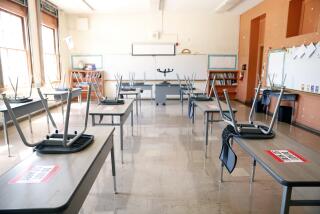Summer of Students’ Discontent
- Share via
Irma Morales, a Long Beach mother, loves the idea. Some Southland middle school students loathe it.
And whereas some teachers think more classroom time for middle-schoolers is good for the children, they fear disruptions in their own lives.
Under a proposal this week by Gov. Gray Davis, more than a million youngsters in the sixth, seventh and eighth grades would go to school an additional six weeks each year. The $1.45-billion plan is sharply dividing everyone involved: educators, parents and students.
“I prefer them to be in school instead of sitting down at home watching TV or doing something outside they shouldn’t be,” said Morales, whose two children attend Washington Intensive Learning Center in Long Beach.
But youngsters, predictably, would rather be in charge of their own summertime plans.
“The kids aren’t going to like it,” said T.J. Bueno, 13, an eighth-grader at Woodrow Wilson Middle School in Glendale.
Chris Hertz, 14, chimed in. Those summers he and his pals spend playing baseball? Those would be toast if Davis’ plan comes to pass.
“We’re kids,” said Crystal Lim, a classmate. “They have to give us a chance to relax. We cherish our vacation.”
Thinking of her brother at Glendale High School, Crystal said she dreaded the thought that he “would just sit and gloat if I were to come home from school and he was on [summer] break.”
Teachers, too, value the long summer break as a time to refresh themselves and further their own educations.
“I take trips to increase my knowledge and recharge my energy,” said Mary Dall, a reading teacher at Wilson.
Logistically, the change poses a big problem for overcrowded urban districts, especially Los Angeles Unified. Of 72 middle schools in the district, 17 are year-round and could not easily add days.
The governor’s proposal, included in the 2001-2002 budget released Wednesday, would be phased in over three years and extend the school year to 210 days from 180. At most schools, students would still have five or so weeks of vacation, starting in late July or August.
The goal, Davis said, is to give students more classroom time so they can lift mediocre test scores. Scores on the Stanford 9--the state’s mandatory standardized test--have tended to flag in middle school, where students have not yet benefited from the bevy of early-grade reforms instituted in recent years.
Delaine Eastin, state superintendent of public instruction, has long advocated a longer school year for all students. It is illogical, she said, for children still to be attending school based on a 19th century agricultural calendar, especially given the longer instructional calendars in Europe and Asia.
That reasoning makes sense to eighth-grader Amanda Padilla, who likes the prospect of a longer school year. She will get a taste of it this year at Washington Intensive Learning Center in Long Beach. Last fall, the school for grades four through eight began testing a 200-day year.
Even the prospect of sitting at her desk in July is “cool with me,” Amanda said. “While other kids are on vacation, they’ll probably forget a lot of things and get bored right away.”
Tom Rozolis-Hill, who teaches U.S. history to Washington eighth-graders, said the longer year could be valuable for students who lag. Whether it is needed for all students is another issue, he said.
“As far as schools performing below expectations, I think that extra time in school really will help,” he said. “We need all the time we can get with these kids.”
The diverse school, which has a hefty segment of children still learning English, scored in the lowest band in the state’s first Academic Performance Index rankings last year. Parents asked for more classroom time for their children. Families must apply to Washington, and children must sign a letter stating that they understand they will be in school longer.
“In this office we’ve just kind of brainstormed,” said Dale Braun, director of school management services with the Los Angeles Unified School District. “We’ve come up with wild and crazy ideas, creative things that we could do.”
Among the schemes she and colleagues have concocted are putting sixth-graders back into elementary schools and adding an hour to the day. But “we don’t know that that would be good quality time,” Braun said.
Richard Lucas, principal at Glendale’s Wilson Middle School, acknowledged that the governor means well but suggested that other schemes, such as reducing class sizes, might be more effective.
Lucas asked teachers whether the added salary that would accompany the longer year would be an incentive. Almost all, he said, preferred time off.
“I would be concerned with the burnout effect on teachers,” he said. “Working with kids is very strenuous.”
Dall, 34, said she was skeptical that the program was workable.
“What do we do with the eighth-graders who graduate and need to go to the high school for summer school?” she said. “What happens to the incoming sixth-graders? It becomes a logistical nightmare.”
More to Read
Sign up for Essential California
The most important California stories and recommendations in your inbox every morning.
You may occasionally receive promotional content from the Los Angeles Times.















